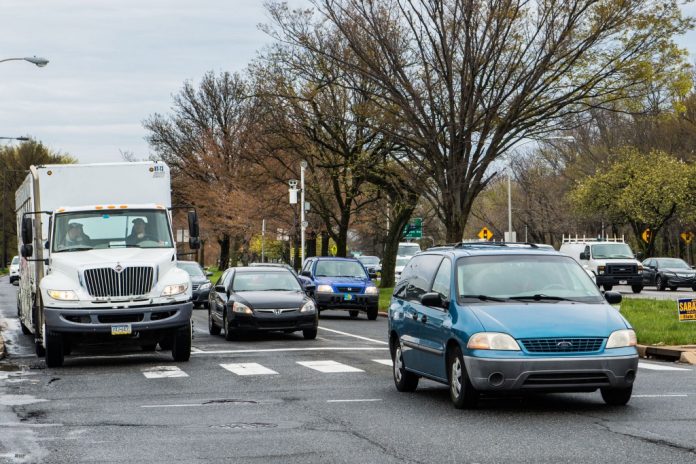Safety first: Roosevelt Boulevard sees about 90,000 vehicles a day. MARIA S. YOUNG / TIMES PHOTO
In case you haven’t heard about it, or worse yet experienced it, Roosevelt Boulevard can become pretty dangerous at times.
The Boulevard garnered national attention in 2001 when State Farm Insurance famously declared two of its intersections as the second and third most-dangerous in the country. Those intersections happen to be about one mile apart in Northeast Philly: at Red Lion Road, where there were 331 reported crashes in 1999 and 2000, and at Grant Avenue, where there were 261 reported crashes in those two years.
More than a decade later, and despite a litany of “improvements” touted by public officials such as red-light cameras, pedestrian crossing timers and emergency pull-off lanes, seemingly not a week passes without news of a major traffic mishap on the 12-lane thoroughfare, which extends 14 miles from near Neshaminy Mall in Bucks County south to Broad Street in the city’s Hunting Park section.
It’s all part of busy U.S. Route 1, Northeast Philly’s transportation spine, and follows essentially the same corridor as the original Lincoln Highway of a century ago. It accommodates about 90,000 vehicles a day, including cars, trucks, commercial rigs and SEPTA buses. To the north and to the south, the road connects with limited-access expressways. But that 14-mile stretch is different. It’s lined with an often-lethal mish-mash of cross streets, pedestrian crosswalks, traffic signals, bus stops, strip malls, convenience stores, hotels, restaurants, office buildings and homes.
Last week, city and state officials announced that they will launch another attempt to fix what’s wrong with the Boulevard — as long as the public will help them pinpoint its fatal flaws.
The three-year, $5 million “Route for Change” program will start with five public forums over the next eight days where the public will be asked to share their experiences with and expectations for the Boulevard. The first event will be Thursday, April 14, from 6 to 8 p.m. at Four Points Sheraton, 9461 Roosevelt Blvd. Additional forums will be on April 16 at Globe Dye Works, 4500 Worth St.; April 19 at Lenfest Center, 3890 N. 10th St.; April 20 at Radisson Hotel, 2400 Old Lincoln Highway, Trevose; and April 21 at Lincoln High School, 3201 Ryan Ave. Spanish interpreters will be available at all of the events. Russian and Chinese interpreters will be available at selected forums. Comments may also be submitted online via www.RooseveltBlvd.com
In September 2014, the Obama administration awarded the city a $2.5 million USDOT TIGER planning grant to fund the study. The city, SEPTA and Pennsylvania Department of Transportation are contributing the other $2.5 million.
“If there is any transportation corridor in the city of Philadelphia where virtually every user would ‘root for change,’ it’s Roosevelt Boulevard,” Mayor Jim Kenney said in announcing the forums on April 6.
For folks who live in the neighborhoods lining the road, daily activities can sometimes resemble the old video game Frogger.
“Our neighbors have to cross 12 lanes of high-speed vehicular traffic, which is the length of a football field, to grab the bus or reach the stores right across the street,” Kenney said.
Certain characteristics of the Boulevard and its surroundings make it a unique challenge for traffic engineers who must figure out how to meet commuter demand while protecting public safety.
“Roosevelt Boulevard is one of very few highways of its kind in the United States, essentially a limited access highway functioning as an urban street in a densely populated area,” said PennDOT District 6 Executive Kenneth M. McClain. “While actions have been taken to make the Boulevard safer despite its physical characteristics, crashes still occur and public safety concerns exist.”
More than 3,000 crashes have been recorded in the last five years on the road, said Angie Dixon, the program’s manager from the city’s Office of Transportation and Infrastructure Systems. The five forums will introduce the program and feature interactive stations to solicit information from attendees. Additional forums will be scheduled over the next three years, leading to the publication of long-term recommendations for roadway improvements in early 2019. Planners will examine traffic configurations and public transportation alternatives, among other topics. ••





